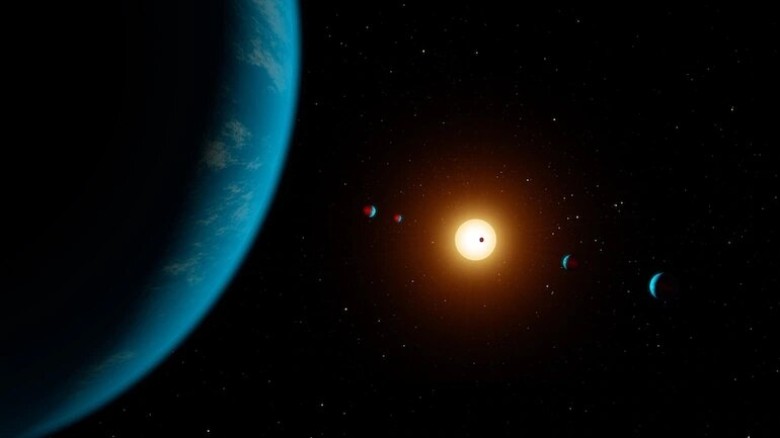North East

Till now, more than 5,000 exoplanets have been identified in the Milky Way, primarily because of NASA's Kepler telescope, which was operational for nine years before running out of fuel in 2018.
Digital Desk: China is now looking at distant solar systems after sending robots to the Moon, landing them on Mars, and building its own space station. Reportedly, scientists will disclose a strategic plan for the country's first mission to find exoplanets this month.
The mission's purpose is to identify the first Earth-like planet orbiting in the habitable zone of a star similar to the Sun outside of the Solar System in other parts of the Milky Way. Astronomers believe that such a planet, dubbed Earth 2.0, would have the ideal circumstances for liquid water to exist and the possibility of life.
Till now, more than 5,000 exoplanets have been identified in the Milky Way, primarily because of NASA's Kepler telescope, which was operational for nine years before running out of fuel in 2018. Some of the planets orbited small red dwarf stars and were rocky Earth-like bodies, but none fulfilled the description of an Earth 2.0.
Jessie Christiansen, an astrophysicist at the NASA Exoplanet Science Institute at California Institute of Technology in Pasadena, said that finding the signal of minor, Earth-like planets with current technology and telescopes is extremely difficult when their host stars are one million times heavier and one billion times brighter.
Chinese mission known as Earth 2.0 is currently in the early design phase and will be supported by the Chinese Academy of Sciences. The mission team will receive money to begin building the satellite if the designs pass a review by a panel of specialists in June. According to the crew, the spacecraft will be launched on a Long March rocket before 2026.
Seven telescopes will be carried by the Earth 2.0 spacecraft, which will observe the sky for four years. Six telescopes will collaborate to examine the Cygnus–Lyra constellations, the same area of sky surveyed by the Kepler telescope. "The Kepler area is a low-hanging fruit since we have solid data from there," says Jian Ge, the astronomer in charge of the Earth 2.0 project at the Chinese Academy of Sciences' Shanghai Astronomical Observatory.
Exoplanets will be uncovered using telescopes that detect slight fluctuations in a star's brightness that signal a planet has passed in front of it. Multiple small telescopes combined to provide a larger field of view than a single giant telescope like Kepler. The six telescopes of Earth 2.0 will look at around 1.2 million stars over a 500-square-degree piece of sky, which is about 5 times larger than Kepler's vision. Earth 2.0 will also be able to see fainter and farther away stars than NASA's Transiting Exoplanet Survey Satellite (TESS), which only sees brilliant stars close to Earth.
"In terms of sky-surveying capacity, our satellite might be 10–15 times more powerful than NASA's Kepler telescope," says Ge.
Also Read: Assam govt to present Cabinet proposal to issue aadhaar for those whose NRC biometrics were locked
The seventh sensor aboard the satellite will be a gravitational microlensing telescope for observing rogue planets (free-roaming celestial objects that don't orbit any star) and exoplanets (like Neptune) that are far from their star. When the gravity of a planet or star warps the light of a background star it is passing in front of, it will detect changes in starlight. The telescope will focus on the Milky Way's center, which contains a large number of stars,
The telescope will focus on the Milky Way's center, which contains many stars, reports said. According to Ge, this will be the first gravitational microlensing telescope to operate from orbit if launched successfully.
"Essentially, our satellite can undertake a census of exoplanets of various sizes, masses, and ages. The expedition will acquire many exoplanet samples for future investigation," he added.
Notably, Kepler was launched by NASA in 2009 to determine how many Earth-like planets are in the Galaxy. To prove if it is Earth-like, astronomers must measure the time it takes to orbit an exoplanet. The orbital period of such planets should be identical to Earth's, and they should transit their suns once a year.
According to Chelsea Huang, an astrophysicist at the University of Southern Queensland in Toowoomba, scientists need at least three transits to determine an exact orbital period, which takes roughly three years of data on average, and occasionally more if data gaps exist.
Parts of the Kepler telescope failed four years into the project, preventing the telescope from staring at a single patch of sky for long periods. Huang, who has worked as a data-simulation consultant with the Earth 2.0 team, said that Kepler was on the verge of discovering some genuinely Earth-like planets.
Astronomers may have another four years of data with Earth 2.0, which, combined with Kepler's observations, may help confirm which exoplanets are Earth-like. "I'm quite thrilled about the potential of returning to the Kepler field," Christiansen says, adding that if the data from Earth 2.0 is made accessible, we plan to examine it.
Ge is hoping to discover a dozen Earth 2.0 worlds. He intends to disseminate the data within a year or two of its collecting. "There will be a lot of data. So we'll need as many hands as possible," he said.
As per reports, the team now contains roughly 300 scientists and engineers, most of whom are from China, but Ge hopes that additional astronomers from worldwide will join the mission.
Planetary Transits and Oscillations of Stars (PLATO) is also an exoplanet mission by the European Space Agency that will launch in 2026. PLATO's architecture includes 26 telescopes, resulting in a far wider field of vision than Earth 2.0. However, every two years, the satellite will alter its focus to monitor other parts of the sky.
Leave A Comment